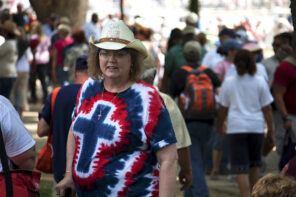“I’m a kind of election supervisor,” says Barry Kosmin, whose 2008 American Religious Identification Survey (ARIS) was released on March 9 with a front-page story in USA Today. For the last week, his phone ringing off the hook, Kosmin has become a lightning-rod for anxiety about the decline of American religiosity. “Whoever doesn’t win the election is going to complain about voting fraud,” he says with a chuckle.
In its first two days online, the ARIS’ 26-page summary report [pdf], authored by Kosmin and his Trinity College colleague Ariela Keysar, scored 40,000 downloads. Christianity, it declares, is on the decline. But the theologically conservative base has grown stronger, with 34% of Americans identifying as “born-again or evangelical.”
“It’s a new fashion statement,” notes Kosmin.
Mainline Protestants continue to dwindle. The Catholic center of gravity is rolling from the Northeast to the Southwest. Meanwhile, the “nones”—the unaligned, agnostics, and atheists—are at 15%, up from 8.2% in 1990 and 14.1% in 2001. Nothing like the previous decade’s change, but not too slouchy. The lion’s share of the headlines declared that religion is losing its grip on Americans. Some mourned, some celebrated, and many were surprised. Wasn’t this, after all, the decade of the values-voter and a new Great Awakening? Perhaps it no coincidence that the pair who produced this survey are also directors of an Institute for the Study of Secularism in Society and Culture. Could a secularist plot be afoot?
There is good reason to wonder. Thanks to Public Law 94-521, passed by Congress in 1976, the national census is prohibited from collecting information about religion. Keeping score in the American religious marketplace, therefore, has become a free-for-all among privately-funded polls and studies, and sectarian concerns have always hovered nearby. America’s best known pollster, George Gallup, was a devoted Christian, as is George Barna, whose Barna Group specializes in religion polls. In recent years, large foundations with religious roots have entered the field, bankrolling surveys and publicizing the results, notably the Lilly Endowment, which “exists to support the causes of religion, education and community development,” and the Pew Charitable Trusts.
One notable example is the John Templeton Foundation, founded in 1987 by the Presbyterian investor whose name it bears. It gave away $70 million in grants last year and boasts an annual Templeton Prize with a larger payout than the Nobel. Among fields as diverse as economics, theology, history, education, physics, neuroscience, and medicine, Templeton has become a force to be reckoned with in the sociology of religion. Some believe that Templeton’s syncretist approach to religion and reason is too weighted toward the theological.
“This is a really awkward time in the sociology of religion,” says Darren Sherkat, a sociologist at Southern Illinois University. He has noticed a “huge influx” of conservative Christians into positions of leadership in the field, editing journals and founding centers. According to his Web site, “I tend to focus on features of religion that are not necessarily so wholesome, with a particular focus on contemporary American conservative Christianity.” This, he believes, has made it harder to get his articles published. “Serious research which questions the Templeton line that religion makes you healthy, wealthy, and wise is unlikely to get a fair review at most journals,” said Sherkat in an interview.
But David Yamane of Wake Forest University, editor of Sociology of Religion, doesn’t see much in these complaints. “Darren publishes prolificly,” he says, “so I don’t think he can claim persecution.” Nor is Yamane worried about the influence of the big foundations. He accepts that “every funding agency has a particular agenda,” and that researchers need to show some interest in “spiritual transformation” to pass muster in Templeton’s eyes, for instance. But he sees no cause for alarm. “I don’t believe it’s a huge intellectual battle going on.”
For both Sherkat and Kosmin, however, the survey run out of Baylor University’s Institute for Studies of Religion reveals how ideology can make its way into statistics. Funded by a grant from Templeton and carried out by the Gallup Organization, the Baylor study reports, contrary to ARIS, that religion is on the rise in America. “That is a clearly sectarian institution,” says Kosmin. “It’s not that I’m insinuating that they’re fiddling with the statistics. But there is a little bit of a skew there.” Backed by large, media-savvy foundations, studies like Baylor have public impact that, in the eyes of some experts, is out of tune with their reliability.
Kosmin and Keysar’s ARIS uses a much larger sample than Baylor—54,461 compared to 1,721—and it has been conducted over almost two decades, while Baylor’s first numbers come from 2006. Because researchers will inevitably craft their survey according to their own interests and assumptions, the ARIS doesn’t give respondents a list of religious identities to choose from. Instead it asks, simply, “What is your religion, if any?” and categorizes the results after the fact. “What we get is true, democratic vox populi,” boasts Kosmin. This approach also, undoubtedly, helps account for its high rate of “nones.”
While, indeed, Kosmin and Keysar lead a center dedicated to the study of the non-religious—the only one of its kind in American academia—they take pains to protect their survey from sectarian bias of its own. They conduct it in conjunction with the Greenberg Center for the Study of Religion in Public Life, located down the hall from them at Trinity College. In addition to the funding they receive from Switzerland’s Posen Foundation—dedicated to “the process of Jewish secularization”—the ARIS depends on the support of the Lilly Endowment, whose Christian leanings are well-known.
For all the ARIS’ merits, though, neither it nor any other study can claim to capture a complete picture of American religiosity. As Gary Laderman pointed out in these pages a few days ago, the very meaning of the sacred for people is a moving target. Various definitions of what religion is in the first place compete just as religions themselves do. Consequently, these surveys don’t stand above the fray of religion in America; they are a part of it.




